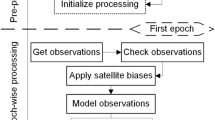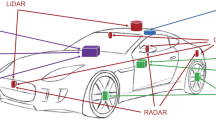Abstract
This paper presents a methodology for the 3D localization and the frequency band estimation of multiple unknown RF sources, using received signal strength (RSS) measurements from a wireless network of static sensors and a moving sensor. Using a particle filter based Bayesian approach, the static sensor network is used to continuously monitor an urban area and provide an estimate of the probability distribution for the states of the unknown sources. Based on this probability distribution, a moving sensor is guided towards locations where it is more likely to find an unknown source. The RSS measurements in the vicinity of the unknown source are used to provide the final estimation and confirmation of the source state. The method is analytically developed and evaluated in terms of accuracy in estimating the number, the 3D location and the frequency band of the unknown sources under different Monte Carlo simulation scenarios.



Similar content being viewed by others
References
Patwari, N., Ash, J. N., Kyperountas, S., Hero, A. O., Moses, R. L., & Correal, N. (2005). Locating the nodes: Cooperative localization in wireless sensor networks. IEEE Signal Processing Magazine, 22(4), 54–69.
Cheng, L., Zhang, C. Wu, Y., Li, H., Wu, M., & Maple, C. (2012). A survey of localization in wireless sensor network. International Journal of Distributed Sensor Networks, 2012, 12.
Gezici, S. (2008). A survey on wireless position estimation. Wireless Personal Communications, 44, 263–282.
Yaghoubi, F., Abbasfar, A.-A., & Maham, B. (2014). Energy-efficient RSSI-based localization for wireless sensor networks. IEEE Communications Letters, 18(6), 973–976.
Rashid, H., & Turuk, A. K. (2013). Localization of wireless sensor networks using a single anchor node. Wireless Personal Communications, 72, 975–986.
Vaghefi, R. M., Gholami, M. R., Buehrer, R. M., & Strom, E. G. (2013). Cooperative received signal strength-based sensor localization with unknown transmit powers. IEEE Transactions on Signal Processing, 61(6), 1389–1403.
Wei, M., Wendong, X., & Lihua, X. (2011). An efficient EM algorithm for energy-based multisource localization in wireless sensor networks. IEEE Transactions on Instrumentation and Measurement, 60(3), 1017–1027.
Meesookho, C., Mitra, U., & Narayanan, S. (2008). On energy-based acoustic source localization for sensor networks. IEEE Transactions on Signal Processing, 56(1), 365–377.
Guvenc, I., & Chong, C.-C. (2009). A survey on TOA based wireless localization and NLOS mitigation techniques. IEEE Communications Surveys and Tutorials, 11(3), 107–124.
Shen, H., Ding, Z., Dasgupta, S., & Chunming, Z. (2014). Multiple source localization in wireless sensor networks based on time of arrival measurement. IEEE Transactions on Signal Processing, 62(8), 1938–1949.
Pal, A. (2010). Localization in wireless sensor networks: Current approaches and future challenges. Network Protocols and Algorithms, 2(1), 45–73.
Elfadil, O. M. (2013). Localization for wireless sensor networks. In 2013 International Conference on Computing, Electrical and Electronics Engineering (ICCEEE) (pp. 548–553).
Rahman, M. S., Youngil, P., & Kim, K.-D. (2009). Localization of wireless sensor network using artificial neural network. In 9th International Symposium on Communications and Information Technology, ISCIT (pp. 639–642).
Denkovski, D., Angjelichinoski, M., Atanasovski, V., & Gavrilovska, L. (2014). RSS-based self-localization framework for future wireless networks. Wireless Personal Communications, 78, 1755–1776.
Gotsis, K. A., Kyriakides, I., Najjar, H. & Sahalos, J. N. (2014). Localization of unidentified RF sources using a moving and a network of stationary sensors. In 8th European Conference on Antennas and Propagation (pp. 3466–3470).
Arulampalam, M. S., Maskell, S., Gordon, N., & Clapp, T. (2002). A tutorial on particle filters for online nonlinear/non-Gaussian Bayesian tracking. IEEE Transaction on Signal Processing, 50(2), 174–188.
Chen, L., et al. (2013). Bayesian fusion for indoor positioning using bluetooth fingerprints. Wireless Personal Communications, 70, 1735–1745.
Dahlman, E., Parkvall, S., & Skold, J. (2011). 4G LTE/LTE advanced for mobile broadband. Amsterdam: Elsevier.
Author information
Authors and Affiliations
Corresponding author
Rights and permissions
About this article
Cite this article
Gotsis, K.A., Kyriakides, I. & Sahalos, J.N. 3D Localization and Frequency Band Estimation of Multiple Unknown RF Sources Using Particle Filters and a Wireless Sensor Network. Wireless Pers Commun 90, 1889–1902 (2016). https://doi.org/10.1007/s11277-016-3429-z
Published:
Issue Date:
DOI: https://doi.org/10.1007/s11277-016-3429-z




